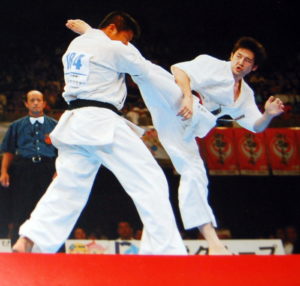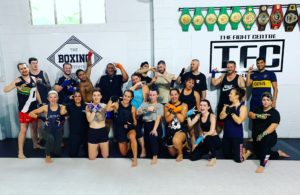The origin of American Kickboxing dates back to the 1970s. At the time, a few karate players branched out to create a more realistic fighting system. A few decades later, the new system has grown to become a sport practised all over the world. But how exactly did Karate evolve to become a different sport? Well, before we get into that, let’s answer this first: what is kickboxing?

Muay Thai is one of the many forms of kickboxing.
-
What Is Kickboxing
In truth, the term kickboxing can be pretty broad. It may refer to any martial art or combat sport that uses both punching and kicking. People may practice it for general fitness, self-defence, and as a contact sport. It has several forms, the most popular of which are:
- Muay Thai (Thai Boxing) is also called The Art of Eight Limbs. There are eight points of contact—pairs of hands, elbows, knees, and feet.
- American Kickboxing (Full Contact) combines Boxing and Karate with other martial arts.
- Dutch Kickboxing is a mix of K-1 rules and Western Boxing.
(Read this article to learn about these styles in detail.)
The list can be pretty long, though. Aside from the above, there are also:
- Semi-contact (Points Fighting)
- International (Freestyle or Low Kick)
- Oriental (Japanese, Unified, or K-1 rules)
- Sanda or Sanshou (Chinese Boxing)
- Shoot boxing (Standing Vale Tudo)
- Lethwei
When people use the term kickboxing, they typically refer to specific styles. Usually, these are the ones that self-identify as such—American, Dutch, and Japanese. Let’s take a look at how Full Contact began, as well as the most prominent sanctioning bodies in the world.
-
The History of American Kickboxing
There is a lot of criticism for karate’s practicality and real-world applicability. This was true in history, and sad as it may be to say, even at present.
Well, for the most part, the same is true for any point-fighting martial arts system. Tactics in such systems gear more towards scoring points than defeating an opponent.
Point-fighting systems are strictly regulated. It comes as no surprise that they may be limiting for more ambitious players.
So when the chance came, several karatekas and promoters broke off to play by their own rules. These are Mike Anderson, Don Quine, and Judy Quine.
And thus, the Professional Karate Association (PKA) came to be. The year 1974 saw the first World Championships of Full Contact Karate in Los Angeles. It brought together a wide array of diverse fighting styles. PKA unified these systems by instituting a standard set of rules. This marked the beginning of American Kickboxing.
In 1986, PKA declined due to legal and revenue reasons. Retiring PKA executives came together and established the International Sport Karate Association (ISKA). Today, ISKA is still a prominent sanctioning body. It covers sports karate, mixed martial arts, and several kickboxing styles.
ISKA held the torch for a good decade or so. Still, the industry later broke up into several governing bodies. Presently, there is no single organization covering all promotions.
These ones, for example, cover multiple rulesets:
- World Kickboxing Association (WKA)
- World Association of Kickboxing Organizations (WAKO)
- International Kickboxing Federation (IKF)
While these are exclusive to the Thai style:
- World Muay Thai Council (WMC)
- International Federation of Muaythai Associations (IFMA)
- World Boxing Council Muay Thai (WBC Muaythai)
- World Professional Muaythai Federation (WPMF)
-
Join the Family
In Person
The Fight Centre mixes multiple styles in every kickboxing workout. Students learn from WBC World Champion Ben “The Blade” Johnston. Want to learn how to throw a kick? Come to The Fight Centre.We offer kickboxing classes for all people of any fitness level. You can enjoy quality instruction from world-class instructors at no cost. Click here to sign up for our free trial classes.



